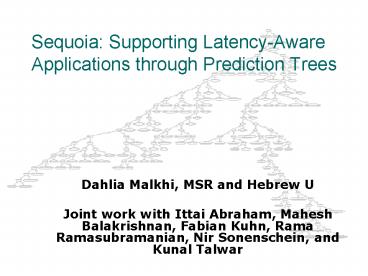Sequoia: Supporting Latency-Aware Applications through Prediction Trees - PowerPoint PPT Presentation
Title:
Sequoia: Supporting Latency-Aware Applications through Prediction Trees
Description:
Spanning trees. Current State of the Art. Application-specific approaches ... (1 O(e)) Steiner approximation for metrics generated from relaxed tree metric graphs ... – PowerPoint PPT presentation
Number of Views:37
Avg rating:3.0/5.0
Title: Sequoia: Supporting Latency-Aware Applications through Prediction Trees
1
Sequoia Supporting Latency-Aware Applications
through Prediction Trees
- Dahlia Malkhi, MSR and Hebrew U
- Joint work with Ittai Abraham, Mahesh
Balakrishnan, Fabian Kuhn, Rama Ramasubramanian,
Nir Sonenschein, and Kunal Talwar
2
Introduction
- Latency-awareness is critical for internet
applications - CDNs, P2P file sharing, network monitoring, etc.
- Latency-enabled functionality
- Closest node discovery
- Locality-based clustering
- Detour routing
- Spanning trees
3
Current State of the Art
- Application-specific approaches
- Closest node Meridian, Oasis,
- Detour routing OneHop Source Routing, Detour,
Akella et al - Clustering SDIMS,
- General-purpose frameworks
- Measurement based inference iPlane
- Requires intrusive, expensive measurements
- Coordinate-based latency prediction Vivaldi,
PIC, GNP, ICS, Virtual Landmarks, PCoord, NPS,
Lighthouse, IDMaps - Needs substantial work to support applications
4
Goals
Internet Topology is not directly known to
end-hosts
Inter-node Ping latencies are available
End-Host Pings
Model
Clustering, Closest Node Discovery
5
Big Insight
It's not a big truck. It's a series of tubes.
Ted Stevens, Senator from Alaska
6
Prediction Trees
Tree of Virtual Routing Nodes
Interior Virtual Routing Nodes Leaves Physical
End-hosts
Distance between nodes is path length on the tree
7
Metric Embedding into Trees
- Generally hard
- Ultra-metric MST yields HST representing
distances precisely - Tree MST yields the right tree
- Tree-metric Bunemans Steiner tree yields the
right tree
8
Is the Internet a Tree?
- The Four-Point Condition
- Given 4 points A,B,C,D
- If ACBD ADBC ABCD,
- ACBC ADBC ABCD
ACBD ADBC
ABCD
9
Is the Internet a Tree? We can model it as one!
Relaxed Four Point Condition ACBDADBC2?
minAB,CD
Internet Latencies are very close to a tree metric
Random power-law graph latencies are also very
close to a tree metric
10
New Challenge Embed Relaxed Tree Metrics in
Trees
- Teriffic experimental evidence
- Distance prediction, clustering, finding closest
nodes, spanning-trees - (1O(e log(n)) ) / (1 O(e log(n)) ) Steiner
approximation - (1O(e log(n)) ) stretch lower bound
- (1 O(e)) Steiner approximation for metrics
generated from relaxed tree metric graphs - (1 O(e)) approximation by log(n) Steiner trees
11
Some Open Directions
- Close lower/upper gap
- Embed random graphs with power-law degrees in
trees - Relaxed tree-metric condition of such graphs
- Embed into distribution on trees
- Embed into fixed-size collection of trees
- Lower bound
- Instance-specific Steiner-tree approximation
12
Thanks!
Sponsored link LOCALITY 2007, Satellite
workshop at PODC 2007, August, Portland Oregon
13
(Re)constructing the Tree
A B C
A 0.0 3.0 5.0
B 3.0 0.0 4.0
C 5.0 4.0 0.0
Cx (ACBC-AB)/2 Ax (ABAC-BC)/2 Bx
(ABBC-AC)/2
14
Growing the Tree
15
Growing the Tree
16
Towards a Distributed System
- Virtual nodes are emulated by surrogate
physical nodes - Distributed Tree-Building Protocol
- Discrete Event Simulator executed on ping data
from PlanetLab, King Datasets
17
Latency Prediction Mechanism
- Distance Labels
- Path to Root
planet0.jaist.ac.jp label (13063473,15203380,6
0223214) planetlab1.cs.ubc.ca label
(25690090,15203380,60223214) Path between them
(13063473, 15203380, 25690090) Distance 19.215
2.767 18.591 20.595 61.168 ms
18
Latency Prediction Performance I
PlanetLab, 117 nodes, 1 month
19
Latency Prediction Performance II
King Dataset (Harvard), 1835 nodes
20
Latency Prediction Multiple Trees
- Each node joins x randomly selected trees out of
t total trees - Existing theoretical work on modeling a graph
metric with a distribution of dominating trees - To predict latencies between 2 nodes, select all
trees both nodes belong to, and pick median
T1
T2
T3
dist(B,C) median(distT1(B,C), distT2(B,C))
21
Latency Prediction Multiple Trees
22
Closest Node Discovery Mechanism
y
Traverse the tree, always picking the neighbor
thats closer to the target
B
D
C
B
x
z
Problem Cant ping inner virtual nodes, only
physical leaf nodes Solution Each virtual node
maintains ping-able representatives for each
virtual neighbor
A
B
C
D
T
- More Overhead ? More Accuracy
- Number of representatives per neighbor
- Number of parallel queries
23
Closest Node Discovery Performance I
PlanetLab, 117 nodes, 1 month ping data
24
Closest Node Discovery Performance II
- King Dataset (Meridian), 2500 nodes
- Meridian performance on same data 1 ms
- Vivaldi, GNP ranging from 8 ms to 18 ms
- (from Wong et al, Sigcomm 05)
q queries, r reps
25
Clustering PlanetLab
Europe
26
Clustering PlanetLab
Poland, Germany, Scandinavia
27
Clustering PlanetLab
Poland
28
Work in Progress
- Explore better tree-building algorithms
- Model other properties using these trees
- Loss rate, bandwidth
- Build a robust distributed system
- Failure Handling, Tree Balancing
29
Conclusions
- Prediction Trees are a promising way of modeling
internet latencies - Simple yet powerful abstraction
- Latency estimation comparable with coordinate
schemes - Closest Node Discovery comparable to Meridian
- Good locality-based Clustering
30
THANK YOU!
31
King Dataset (harvard)
- 1835 Nodes
32
Four Point Condition
- Relaxed 4PC
- d(AC)d(BC) d(AD)d(BC) ? d(AB)d(CD)
33
Prediction Trees
- Interior nodes are virtual steiner nodes
- Leaf nodes are physical end-hosts
- Estimated Distance is Path Length on the Tree
34
Clustering PlanetLab
All European Nodes
35
Clustering PlanetLab
German and Scandinavian nodes Hostname ends with
de OR fi OR no OR se































